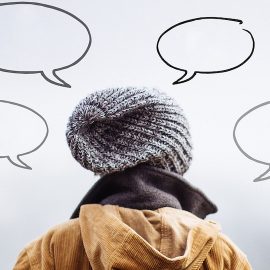

This article is an excerpt from the Shortform book guide to "Atlas of the Heart" by Brené Brown. Shortform has the world's best summaries and analyses of books you should be reading.
Like this article? Sign up for a free trial here .
What is Brené Brown’s Atlas of the Heart about? What is the key message to take away from the book?
Many people can only recognize and name three emotions: happiness, sadness, and anger. This lack of vocabulary blocks us from being able to fully experience and share our feelings with others—and that prevents us from forming connections with each other. In her book Atlas of the Heart, Brené Brown provides descriptions and explanations of 87 emotions, along with the situations where you’re likely to encounter them.
Below is a brief overview of Atlas of the Heart by Brené Brown.
Important Terms
In her book Atlas of the Heart, Brené Brown—a popular public speaker, bestselling author, and professional social worker—provides a guide to the many emotions and mental states that people feel. Brown’s hope is that, with a deeper understanding of emotions, you’ll be able to talk about them more openly and accurately, and thus form deeper connections with the people around you.
Brown uses a few important terms that you may not be familiar with or you may not know in the same sense that she uses them. Therefore, we’ll start by defining those terms.
Brown frequently describes feelings as either a trait or a state. In brief:
- A trait is an aspect of your personality, or a characteristic thought pattern. In other words, it’s a more-or-less permanent part of how you think or act. For example, confidence is a trait that many people strive for: No matter the situation, some people always seem to be sure of themselves and in control.
- A state is a temporary condition brought on by a particular event or situation. For example, anger isn’t a permanent part of your personality (hopefully); rather, something happens that makes you angry. Atlas of the Heart is primarily concerned with states.
(Shortform note: It’s easy to mistake a state for a trait, especially in someone you don’t know very well. For example, if you happen to meet someone who just received upsetting news, you might think that he or she is quiet and withdrawn (traits), when in reality she is just sad (a state). In fact, confusing states with traits is so common that psychologists call it the Fundamental Attribution Error.)
When Brown talks about connection, she specifically means an emotional link between two people. Such a link allows both people to be truthful and vulnerable with each other, and to draw emotional strength and support from one another. A great deal of Brown’s work, including much of Atlas of the Heart, is about how to recognize and build meaningful connections between people.
(Shortform note: Brown believes that deep, meaningful connection is one of the three things that all people need to be truly happy and fulfilled; the other two needs are love and belonging. In Daring Greatly, Brown says that meeting those three needs is the path to living wholeheartedly—that is, engaging fully with your life and feeling worthy of love, connection, and belonging. She also says that fear and shame hold us back from forming connections and living wholeheartedly.)
Finally, the author finds value in the idea of near enemies: two things that seem similar, but actually oppose each other. The term grew out of Buddhism and originally described something that seemed to be a helpful spiritual trait, but in reality got in the way of a person’s spiritual growth. For example, making grand shows of piety might make you look devout and enlightened, but you’re really just doing it to get attention and approval from others.
Brown frequently extends the idea of near enemies to emotions or thought patterns—for instance, jealous possessiveness might look like love, but it harms relationships instead of helping to build them.
How We Relate to Ourselves
The first category of feelings we’ll examine are those relating to the self. Brown explains that many of our mental states are purely internal: They provide feedback about the current state of our lives and personal situations. Common self-focused feelings are sadness and disappointment—and, at the other end of the spectrum, happiness and pride.
When We Experience Loss: Sadness
To begin, sadness is a painful feeling that we experience in response to loss. Sadness is a fundamental human emotion—in fact, Brown says it’s one of the few states that people regularly report being able to identify.
While sadness is driven by loss (for example, of a loved one, a cherished item, or even of a comforting idea), it also implies acceptance of that loss. That makes sadness different from grief, which combines painful feelings of loss with a desire to get back what we lost, even if that’s impossible.
Hopelessness is closely related to sadness. Hopelessness is a response to loss of control (or perceived loss of control)—it’s the feeling that we’re unable to change things for the better.
Brown says that hopelessness has three root causes:
- Not knowing what we want
- Knowing what we want, but not how to get it
- Knowing what we want and how to get it, but still not believing that we can
She adds that the combination of hopelessness and sadness is called despair. Despair means that we’re suffering, and we don’t think there’s anything we can do about it.
When We Feel Inadequate: Shame
Like sadness, shame is another all-too-common self-focused state. Brown defines shame as the feeling that you’re an inherently bad or flawed person. When we feel shame, we might believe that we’re unworthy of love or incapable of change.
Brown says we all carry shame, and we don’t like to talk about it. However, shame thrives in isolation, so refusing to acknowledge our shame only gives it more power over us. Bringing shame out into the open allows us—and those we love—to confront it with empathy and compassion.
A side note: People often use embarrassment interchangeably with shame, but Brown says that it’s much less serious and much shorter-lived than true shame. Embarrassment occurs when something makes us feel foolish or uncomfortable, but not like we’re bad people. For example, dripping sauce onto a nice shirt is embarrassing, not shameful.
Humiliation is what we feel when someone else insults or disparages us. Brown says it’s a similar state to shame, but the difference is that humiliation comes from an outside source. With humiliation, we don’t feel like we deserve the feelings of unworthiness and isolation—although that doesn’t make the feelings go away.
Finally, guilt is also similar to shame, but focuses (appropriately) on what we’ve done instead of who we are. Brown says that guilt gives us not only the ability but also the desire to make positive changes.
For instance, someone who gets fired for missing work too often might say, “I didn’t work hard enough” instead of, “I’m too lazy.” The difference is that not working hard enough is a specific and solvable problem, whereas laziness is a character trait that seems much harder to change.
(Shortform note: On her personal website, Brown talks more about the difference between shame and guilt. She believes that we should use guilt, not shame, to motivate ourselves and others—in other words, we should point out when people do something wrong but not resort to attacking their identities with insults and labels.)
When Things Are Going Well: Happiness
At the other end of the emotional spectrum from sadness is happiness. Brown defines happiness as pleasure related to your surroundings or your current circumstances. However, happiness isn’t just a single state, it’s also the foundation of numerous others.
Gratitude is related to happiness, but it’s an active process: It means taking time and energy to appreciate what you have and what brings meaning to your life.
Joy is a brief state of intense happiness. Brown believes that joy stems from a feeling of deep connection and appreciation, and that it has a spiritual aspect—a sense of experiencing something greater or more powerful than ourselves. Joy can occur in response to a person, an environment, or an experience—for example, seeing someone you love, standing by a beautiful waterfall, or losing yourself in a dance can all spark joy.
Contentment is a pleasurable feeling that comes from knowing your physical, emotional, and spiritual needs have been met. It’s the satisfaction that comes from finishing your work, whether you’re finished for the day, the week, or the rest of your life. Brown says that contentment is a mild feeling—if joy is at the high end of the happiness spectrum, contentment is at the other end.
Tranquility is closely related to contentment: It’s the peace that comes from having no work to do. In other words, whereas contentment is the satisfaction of finishing your work, tranquility is the pleasure of having no upcoming demands on your time or energy.
Brown also says that our culture tends to devalue contentment and tranquility. People believe every moment should be joyful or exciting, so they constantly chase those highs, making simple contentment feel dull by comparison. However, it’s impossible to be joyful all the time—Brown suggests learning to enjoy moments of contentment and tranquility, instead of being disappointed that we’re not experiencing something more intense.
When We Assess Ourselves: Confidence
Finally, if happiness is taking pleasure in our surroundings, confidence means taking pleasure in ourselves. Brown defines confidence as self-esteem, or a sense of certainty in our own abilities.
Brown wants us to work toward a particular form of confidence that she calls grounded confidence: a powerful sense of self that comes from accurate analysis of what we’ve done and what we can do. For example, an accomplished performer might still feel stage fright, but she can draw confidence from the knowledge that she’s experienced and skilled, and that audiences love her shows.
Brown adds that defensiveness comes from a lack of grounded confidence—we feel the need to protect ourselves from anything that might disrupt our self-image or sense of self-worth, so we immediately turn to justifications and excuses for any negative traits we have and any mistakes we make.
(Shortform note: In The Confidence Code, the authors note that the commonly accepted image of confidence is how men traditionally express it: We imagine someone boasting about his skills, forcefully making decisions, and rolling over anyone who tries to argue with him. However, confidence doesn’t have to be loud and aggressive—someone who can listen quietly, make a decision calmly, and admit when he doesn’t have all the answers is also displaying confidence.)
On the other hand, humility is grounded confidence combined with a willingness to learn and improve. While it’s often considered to be the opposite of confidence, Brown says that humility is actually a function of confidence—we have to be secure enough in ourselves to recognize when we might be wrong and when we have room to grow.
Brown sums up humility by quoting another of her books, Dare to Lead: “I’m here to get it right, not to be right.”
(Shortform note: In Dare to Lead, Brown continues her discussion of humility by saying that humble people are those who ask questions, think critically, and admit when they don’t know something. In contrast, people who lack humility act like they know everything: They refuse to ask questions, believe their ideas are the only good ones, and clash with anyone who disagrees with them or proves them wrong.)
The near enemy of confidence is hubris, which is an overblown sense of our own capabilities that’s not tied to any actual achievements. Counterintuitively, Brown believes that hubris is actually a function of low self-esteem. Much like defensiveness, people who lack confidence feel the need to build themselves up and defend themselves from any negative attention—even (or perhaps especially) negative attention from themselves.
A side note: Brown adds that people often use the word pride when they mean hubris. However, pride is a healthy and positive state of satisfaction with achievements—our own or someone else’s.
(Shortform note: There are stories and cautionary tales about hubris dating all the way back to ancient Greece, notably the story of Icarus. Icarus’s father gave him a set of wax wings that allowed him to fly, but in his hubris, Icarus ignored his father’s warnings and flew too high. The sun’s heat melted the wax, and Icarus fell to his death. This story illustrates how hubris can lead us to believe that we’re invincible, or that we know better than anyone else, and the dangers of thinking that way.)
How We Relate to External Events
Some of our feelings don’t directly tell us about ourselves; rather, they’re responses to what we perceive happening around us.
When Dealing With Uncertainty: Stress and Anxiety
When events demand more of us than we feel we can give, we experience stress. For example, if you have more work on your plate than you can handle, you probably feel stressed about it. When we’re stressed, we benefit from support; we need people to ask how they can help and to take some of the work off of our plates.
In extreme cases, we can become so stressed that we can’t even function—Brown calls this state overwhelm. We’re so overloaded that we shut down physically and mentally. Others asking us what we need is not helpful here, because we might not be able to come up with an answer. The only way out of overwhelm is to take a break, disconnect, and do nothing for a while.
(Shortform note: Rest is crucial to prevent stress from growing into overwhelm or burnout. In The 5 AM Club, Robin Sharma explains that rest actually has two crucial functions: First, it allows you to recover from working so that you avoid exhausting yourself. Second, it allows your body and mind to strengthen themselves in response to the work you did—this applies equally to physical exercise and practicing skills.)
Anxiety, simply put, is concern about the future. Brown explains it as feeling like we’re not in control—we don’t know what’s going to happen, so we imagine the worst. For example, if you’re waiting for the results of a medical test, you might be anxious about what those results will show.
Interestingly, excitement is nearly identical to anxiety, but we interpret the feelings in a positive way instead of a negative one. For example, one person might find gambling thrilling, while another can only imagine losing all of his or her money.
Whereas anxiety is concern about the unknown, fear is a response to a perceived threat. Fear is a short-lived sensation that prepares us to deal with immediate danger using Fight, Flight, or Freeze responses.
- Fight: defending ourselves from the danger
- Flight: escaping from the danger
- Freeze: stopping in place, hoping the danger will pass us by without noticing
(Shortform note: Fear is such a powerful emotion because it’s hardwired into our biology—it kept our ancestors safe from predators and other dangers, and it still helps keep us alive today. Unfortunately, while fear is useful, what we feel is often disproportionate to any actual threat. For instance, there’s no need to fight, flee, or freeze in response to an exam question; all you can do is answer it.)
When Reality Falls Short of Expectations: Boredom and Disappointment
Brown describes boredom as wanting to do something fulfilling and not being able to. You feel understimulated, your tasks (if you have any) seem meaningless and unsatisfying, and time seems to stretch out.
If you’re in control of the situation, boredom is likely to leave you feeling lazy and lethargic—for example, if you’re sitting at home and simply can’t find anything to fill the time. Conversely, when you’re not in control, boredom is more likely to make you feel antsy and frustrated; like being stuck at school or work and wishing you could do something else.
(Shortform note: In Atomic Habits, James Clear has a different idea of where boredom comes from: lack of novelty and lack of challenge. In other words, if we’re doing something that’s both familiar and easy, we’ll quickly become bored with it. Clear’s solution to boredom is to keep things interesting by coming up with new challenges for yourself—make these challenges tough enough to be interesting, but not so difficult that they’re frustrating. For example, if you’re getting bored at your job, you might challenge yourself to do your work more quickly (but just as well) or look for a new skill to add to your repertoire.)
Disappointment is the negative state that you feel when your expectations aren’t met. Brown says the more important the expectation was to you, the deeper and more painful the disappointment will be. For example, if you wanted pizza for dinner and wound up eating chicken, you might experience mild discomfort from your disappointment. On the other hand, if you were expecting your partner to throw you a birthday party but he forgot that it even was your birthday, you might feel deeply hurt.
Brown adds that regret is similar to disappointment, but it’s specific to times when you think the outcome was in your control. In other words, regret is disappointment plus guilt: Things didn’t play out the way you wanted, and it feels like it’s your own fault.
Brown briefly touches on three other common responses to events playing out differently than you hoped or expected:
- Frustration: It feels like you could create the desired outcome, but something outside of your control is preventing it.
- Discouragement: You’re losing confidence in your ability to create the desired outcome. As a result of that, you’re also losing the motivation to keep trying.
- Resignation: The endpoint of discouragement—you no longer believe that you can change the situation, and you’ve totally given up trying.
(Shortform note: In How to Stop Worrying and Start Living, Dale Carnegie discusses how to let go of these feelings by accepting what you can’t change and focusing your efforts on things that are within your control. His advice includes taking things one day at a time instead of fretting about what might happen later, keeping yourself busy with what you can do, and making the best of the situation—for instance, if a power failure ruins your dinner plans, that could be an opportunity to go to that new restaurant you’ve been meaning to try.)
How We Relate to Other People
Our emotions don’t just give us feedback about our own lives, they also provide valuable guidance in social situations. However, Brown explains that we have to understand what they’re trying to tell us and recognize when those messages are misguided.
When used correctly and channeled into positive actions, our emotions are a powerful force of love and connection; used improperly, they cut us off from each other, leaving us divided and hateful.
When Something Is Wrong: Anger and Disgust
Anger is what we feel when something gets in the way of what we want or disrupts the way we think things are supposed to be. Brown says that anger is a highly active state—it makes us want to lash out, fix the perceived problem, and hurt whatever (or whoever) caused it.
Disgust is a strong aversion to something or someone. Brown believes that disgust stems from wanting to protect ourselves from toxic substances, but that protective instinct has somehow extended to protecting ourselves from “toxic” people and ideas.
The author adds that the combination of anger and disgust is contempt. Contempt is usually directed toward people, and it’s the belief that not only has a person done something wrong, but that he or she has some deep, fundamental flaw. In other words, contempt doesn’t just say, “You did a bad thing”; it says, “You’re a bad person, and I’m better than you.”
Finally, hate is a powerful combination of contempt and fear reserved for those we believe are truly evil. We believe that those we hate are not just bad people, but also dangerous people who need to be destroyed.
When We Feel for Others: Empathy
Brown says that empathy is the ability to understand and echo what someone else feels. However, note that empathy doesn’t mean imagining yourself in someone else’s place, or “walking a mile in his shoes,” as the old saying goes—trying to do so will cause you to bring your own biases and experiences to the situation. Rather, it means that you understand and accept the other person’s feelings, even if they might not be the same feelings you’d have in his place.
Brown adds that compassion is empathy plus action: It’s the practice of relating to others and, as a result, acting to ease their suffering.
(Shortform note: Compassion and empathy both literally mean “suffering with.” It’s unclear exactly when or how compassion became associated with action, but many other writers agree with Brown about this distinction. Some add that, because it involves action, compassion is preferable to empathy.)
Brown says that sympathy is the near enemy of empathy: It looks the same, but there’s no sense of connection. Just the opposite, in fact—sympathy draws a clear line between the person suffering and ourselves. In other words, sympathy is feeling bad for someone, but being unable (or unwilling) to relate to that person.
The author adds that pity is sympathy with a sense of hierarchy: We don’t just feel bad for the person suffering, we feel like he or she is somehow “less than” we are. For instance, drug addicts are common subjects of pity—people often feel bad for them, but also consider them distasteful or dangerous, and they may even blame the addicts for their own situations.
(Shortform note: Another way to recognize sympathy and pity is that they’re inactive states. In other words, we feel like we’re either not able or not obligated to help people whom we feel pity for. For example, if you encountered a drug addict on the street, you could theoretically pay for treatment to help him get better. However, that would require significant sacrifice on your part—sacrifice that you’re likely unable or unwilling to make for a stranger. In short, if you feel a genuine connection and desire to help, then you’re experiencing compassion born from empathy; if you just “feel bad” for someone and don’t feel a strong desire to act, then you’re experiencing pity born from sympathy.)
Pity involves comparison: evaluating or ranking ourselves in relation to others. Those self-assigned “ranks” can affect everything from how we speak to others to how we feel about ourselves.
Brown notes a common misconception about comparisons: Thinking that others are “above” us makes us feel bad, while thinking others are “below” us makes us feel good. In fact, either type of comparison can cause positive or negative emotions. For instance, thinking that someone is stronger, smarter, or more skilled than you could be disheartening, but it could also inspire you to try to reach his or her level. Similarly, thinking that others are worse than you in some way might feed your ego, or it might frustrate you that they don’t live up to your standards.
(Shortform note: Comparison is pervasive and powerful because, as Richard Dawkins explains in The Selfish Gene, competition is hardwired into our biology. Every living organism competes with others: They compete for resources, territory, mates, and so on. Those competitions often involve comparing themselves to each other in some way other than actually fighting. Therefore, they instinctively compare their sizes, weights, and social standings; they might also posture and make threatening displays. Whatever the method, the result is that both competitors know where they stand in relation to each other. That drive for comparison and competition is still inside each of us today.)
When We Reach Out to Others: Love, Trust, and Vulnerability
Brown defines love as a deep and fulfilling connection between people. Brown says that love begins with deep trust and the freedom to be yourself: You open yourself up to another person, and that other person opens up to you. You leave yourselves vulnerable to each other and honor that shared vulnerability with kindness, respect, and warmth. In other words, love is a deep form of shared belonging.
Trust is the choice to take something that’s important to you and make it vulnerable to another person—it’s the belief that something you value deeply will be safe with another person. For example, when you hire a babysitter, you’re trusting that person with your child; when you confess your feelings for someone, you’re trusting that person with your emotional well-being.
Vulnerability is what you experience when you take a risk, or leave yourself open to emotional harm. Even Brown has a hard time explaining exactly what vulnerability is, but it’s what you might feel when you confess your feelings for someone or ask for feedback on a deeply personal issue—it’s the knowledge that you’ve exposed an emotional weak spot and that someone could use it to hurt you.
However, Brown says that vulnerability is a prerequisite for courage: You have to make yourself vulnerable in order to take big chances like starting a new career, entering a new relationship, or taking on a leadership role.
Belonging Versus Fitting In
Brown says that belonging is when you can truly be yourself, and the people around you love you for it. To put it another way, belonging means being someplace where you want to be, and others want you there; it’s a true connection with a group of people.
Conversely, “fitting in” is the near enemy of belonging: It resembles true belonging, but lacks the connection and love. It’s being somewhere you don’t necessarily want to be, and where you have to adjust your behavior to match the others. Far from trying to forge genuine connections, you’re putting up a false front just to avoid negative attention.
(Shortform note: Another way to look at the difference between belonging and fitting in is: Fitting in means changing yourself to match your environment, while belonging means finding or creating an environment that matches you. In other words, fitting in means focusing outward, while belonging means focusing inward. Therefore, it’s natural that true belonging is more personally fulfilling than simply fitting in.)

———End of Preview———
Like what you just read? Read the rest of the world's best book summary and analysis of Brené Brown's "Atlas of the Heart" at Shortform .
Here's what you'll find in our full Atlas of the Heart summary :
- Brené Brown's guide to the many emotions and mental states that people feel
- Explanations of 87 emotions, along with the situations where you’re likely to encounter them
- How to form deeper connections with the people around you






